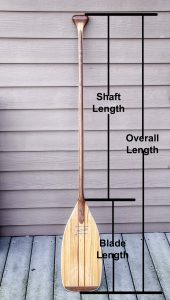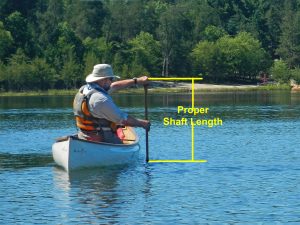This one’s too long; This one’s too short; This one is just right.
by Marc Ornstein
I’ve read and heard dozens of ways to size a canoe paddle.
- Sit on a stool and place your hand here and the grip there…
- Spread your arms as wide as possible. Put the grip in one hand and…
- Stand upright, place the tip of the blade on the ground and the grip should reach your …
- Paddle should be 6” shorter than your body height —————-and the list goes on.
Most of these methods will get you in the correct ballpark, but there’s a better way.
To be clear, this article is about sizing a straight blade (not a bent shaft). It is for those interested in “North American Canoe Touring” and or FreeStyle. Single blade whitewater paddlers may also find this useful though some may disagree. Likewise, “Canadian” style paddling (though obviously North American) is a beautiful discipline but one for which the paddle requirements are quite different.
 The critical length measurement is that of the shaft, measured from the top of the grip to the throat (where the blade begins). The length of the blade, itself, is largely insignificant as it is largely submerged. Unfortunately, most paddles are marketed by their overall length, combining both the shaft and blade length, thus a paddle with a 37” shaft length and a 20” blade is commonly sold as a 57” paddle. Here is how I recommend sizing a paddle.
The critical length measurement is that of the shaft, measured from the top of the grip to the throat (where the blade begins). The length of the blade, itself, is largely insignificant as it is largely submerged. Unfortunately, most paddles are marketed by their overall length, combining both the shaft and blade length, thus a paddle with a 37” shaft length and a 20” blade is commonly sold as a 57” paddle. Here is how I recommend sizing a paddle.
- Position yourself in your canoe in your preferred paddling stance, be that sitting on a raised seat or kneeling with one knee in each chine and fanny against the front rail of the seat or a kneeling thwart.
- Extend your grip hand/arm across your body, at approximately shoulder height so that your grip hand is outboard of the gunwale, as if you were in the final phase of a power stroke.
- Measure from the inside of your grip hand to the water surface. That is the proper shaft length. Measuring this by yourself could be tricky so instead, take any old paddle you have handy or even a stick. Put the grip of the paddle or either end of the stick in your grip hand and let the other end dangle in the water. Then measure from the grip end to the waterline on your measuring stick to obtain the proper length.
I wish I could tell you that this is definitive but it’s simply a starting point. The difference between this starting point and the methods mentioned earlier is that this measurement takes into account variations in torso and thigh length. It accounts for how high or deep your canoe sits in the water. If you commonly trip with a heavily laden canoe, put the equivalent weight in the canoe before you make your measurement and that too will be accounted for. If you have several canoes of varying displacement, measuring from each will result in slightly different shaft lengths, but unless the hulls are dramatically different (e.g., a 16’ prospector vs a 13’ Flashfire) the differences will be small and your body will easily adapt.
mentioned earlier is that this measurement takes into account variations in torso and thigh length. It accounts for how high or deep your canoe sits in the water. If you commonly trip with a heavily laden canoe, put the equivalent weight in the canoe before you make your measurement and that too will be accounted for. If you have several canoes of varying displacement, measuring from each will result in slightly different shaft lengths, but unless the hulls are dramatically different (e.g., a 16’ prospector vs a 13’ Flashfire) the differences will be small and your body will easily adapt.
For many paddlers this will be the end of it. If they obtain a suitable paddle with this shaft length, it will serve them well and they may be quite happy with it but experienced paddlers may want to make some adjustments. Paddlers who routinely do a lot of cross strokes/maneuvers may want a slightly longer shaft. A paddler with a compromised shoulder may prefer one a bit shorter.
Most paddlers carry a spare and this can be an opportunity to have an alternate length available. Instead of carrying an old beater that you hope not to ever use, carry a quality paddle that you do expect to use under specific conditions but will also serve as a spare.
I generally use a 36” shaft paddle with a 20” blade. It’s my preferred paddle for general touring and FreeStyle. My favorite paddling venues are narrow, twisting streams where one commonly encounters shallow sections. My preferred spare paddle has a 34” shaft and 18” blade making the overall length, 4” shorter than my main paddle. That 4” difference is enough to prevent holding the blade uncomfortably high in the shallows but with the overall length difference split between the blade and the shaft, it is still a functional paddle in all situations should my main blade be lost or damaged.
So, there you have it. The long and the short of it for sizing a single blade, straight shaft, canoe paddle.